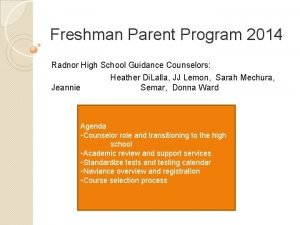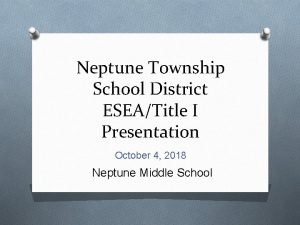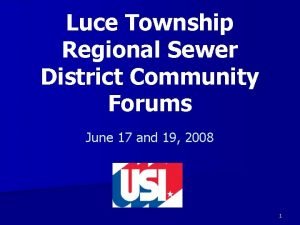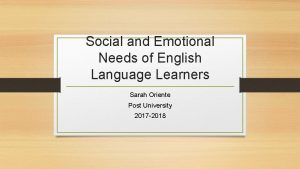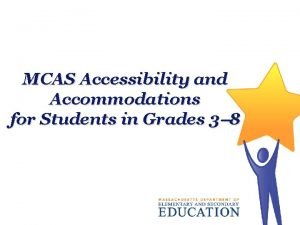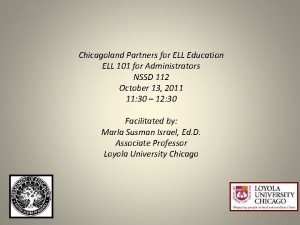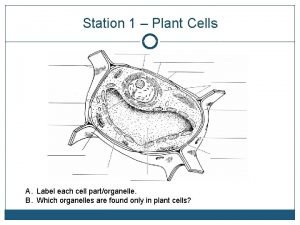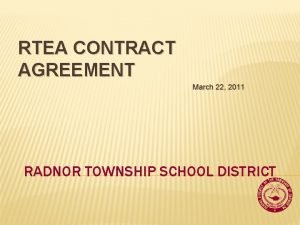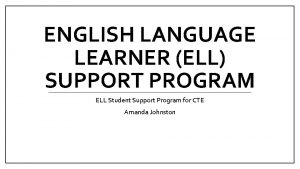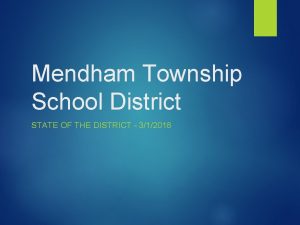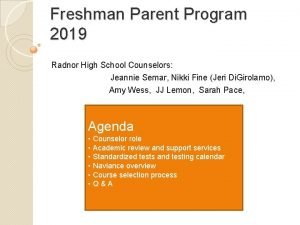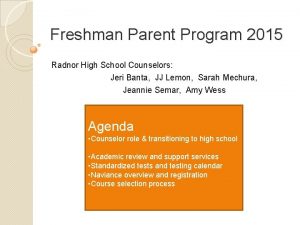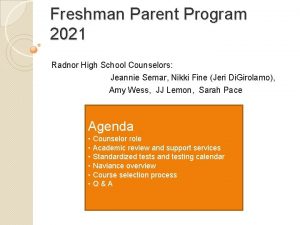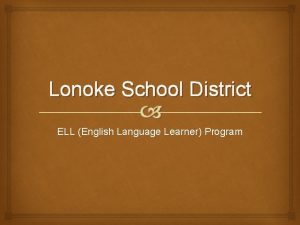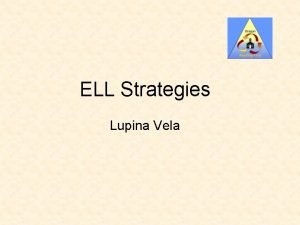ELL Program Radnor Township School District The Koi
















- Slides: 16

ELL Program Radnor Township School District

The Koi Fish Story A favorite fish among many hobbyists is the Japanese carp, commonly known as the koi. The fascinating thing about the koi is that if you keep it in a small fish bowl, it will only grow to be two or three inches long. Place the koi in a large tank or a small pond and it will reach six to ten inches. Put it in a large pond and it may get as long as a foot and a half. Information from the DCIU ELL Department

What size fish bowl are your ELLs in?

ELL 101 ELL is funded through the Title III program of the NCLB Act of 2001 l PA recently updated the Basic Education Circulars for ELL (April 14, 2009) l l Instructional placement of ELLs must be age and grade appropriate ELLs must be given equal access to all educational programs, opportunities, and extra curricular activities in the same manner as for all students Parent permission to assess IS NOT REQUIRED

WIDA…What is it? PA is one of 21 states which make up the WIDA (World-Class Instructional Design and Assessment) Consortium. l All schools in PA follow the guidelines and standards of WIDA. l The WIDA Consortium has developed: l English language proficiency standards l English language proficiency test aligned with those standards (ACCESS for ELLs®) l Information from www. wida. us

Entrance Criteria Home Language Survey l W-APT l l Assesses English language proficiency in Listening, Speaking, Reading and Writing The W-APT can only be administered once per calendar year. Grades 1 -12 l Score of 4. 5 and below qualifies a student for the ELL program l Kindergarten l Score of 24 and below on Listening and Speaking only

Exit Criteria l ACCESS for ELLs® test l l Composite score of 5. 0 or higher on Listening, Speaking, Reading and Writing PSSA l Score of Basic or higher on Reading, Writing, and Math l l Final grades of C or higher in content area classes District reading assessments l Students are monitored for 2 years after exiting from the ELL program *Students may not be exited from the language instructional program based only on their oral proficiency; proficiency in academic reading and writing must also be assessed.

ELL Instruction l ELL curriculum must be aligned with: PA’s Language Arts Standards l PA’s ELPS (English Language Proficiency Standards) for ELLs l l The ELL program includes English instruction across the four language domains (Listening, Speaking, Reading, and Writing)

The Four Language Domains l Listening – process, understand, interpret, and evaluate spoken language in a variety of situations l Speaking – engage in oral communication in a variety of situations for an array of purposes and audiences l Reading – process, interpret, and evaluate written language, symbols and text with understanding and fluency l Writing – engage in written communications in a variety of forms for an array of purposes and audiences l Information from www. pde. pa. state. us

Pennsylvania Academic Standards vs. English Language Proficiency Standards Academic Standards Are for all students l Guide the alignment of content curriculum l Guide content instruction l Comprise of content specific objectives l Information from DCIU ELL Department ELP Standards Are for ELLs l Are aligned to PA Academic Standards, WIDA Standards, and National TESOL standards l Guide district ESL curriculum and instruction l Include both content and language objectives l

PA English Language Proficiency Standards Standard 1: Social & Instructional Language Standard 2: Language Arts Standard 3: Math Standard 4: Science Standard 5: Social Studies The ELPs are clustered by grade levels: Grades Pre-K, 1 -3, 4 -5, 6 -8, 9 -12

Levels of English Language Proficiency 6 5 BRIDGING 4 EXPANDING 3 DEVELOPING 2 BEGINNING 1 ENTERING Information from www. pde. pa. state. us R E A C H I N G

Language Performance Definitions for the Levels of English Language Proficiency Figure 1: Linguistic characteristics at levels of language proficiency Across the curriculum… Level 1 Entering Level 2 Beginning Level 3 Developing Level 4 Expanding Level 5 Bridging at the given level of English language proficiency, English language learners in Pennsylvania, can process and understand. R E C E P T I V E P R O D U C T I V E Pictorial or graphic representation of the language of the content areas with minimal comprehension. General language related to the content areas. General and some specific language of the content areas. Specific and some technical language of the content areas. The technical language of the content areas. at the given level of English language proficiency, English language learners in Pennsylvania, can use and produce. Non-verbal communication, single words or short phrases which may be demonstrated by repeating and copying words and phrases, or use of first language. Common phrases or short sentences and some general academic language in oral and written communication with errors that may impede meaning. Information from www. pde. pa. state. us Familiar oral and written language of expanded sentence length, short paragraphs, and academic language with occasional errors. Oral and written academic and technical language of varying complexity in context with nominal errors. Oral or written academic and technical language of varying complexity approaching that of English proficient peers with minimal errors.

Classroom Instruction for ELLs must be graded using the same grading system as all other students l ELLs must be provided with “meaningful, comprehensible access to instruction in all content areas” (www. pde. state. pa. us/k 12) l l l Curriculum in all content areas must be modified and differentiated according to their language proficiency level: (Entering, Beginning, Developing, Expanding, Bridging) Suggestions for modifications are found in WIDA’s CAN DO Descriptors http: //www. wida. us/standards/CAN_DOs/index. aspx

What are the expected outcomes? ELL students will have meaningful access to the full curriculum. l ELL students will progress with their English language development while meeting academic content standards. l ELL students will acquire the language and content necessary to exit the formal ELL program and demonstrate academic achievement across the curriculum. l Information from DCIU ELL Department

References/Resources l l l Center for Applied Linguistics www. cal. org PA Department of Education www. pde. pa. state. us National Clearing House for English Language Acquisition www. ncela. gwa. edu Office of English Language Acquisition www. ed. gov. oela World-Class Instructional Design and Assessment www. wida. us Teachers of English to Speakers of Other Languages www. tesol. org Information from DCIU ELL Department
 Radnor township school district
Radnor township school district Mindful coach radnor
Mindful coach radnor Radnor high school grading scale
Radnor high school grading scale Southampton township school district
Southampton township school district Neptune township school
Neptune township school Alma wwjh
Alma wwjh Luce township regional sewer district
Luce township regional sewer district Tylers crabs
Tylers crabs Simple key loader
Simple key loader Koi
Koi Aur manorath jo koi lave
Aur manorath jo koi lave Asian fish drawing
Asian fish drawing Fish gall
Fish gall Social emotional needs of ell students
Social emotional needs of ell students Mcas ell accommodations
Mcas ell accommodations Ell 101
Ell 101 Quizizz
Quizizz


